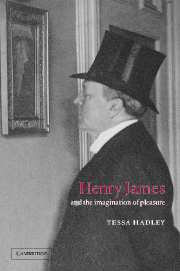Book contents
- Frontmatter
- Contents
- Acknowledgements
- Introduction
- 1 ‘Just you wait!’: reflections on the last chapters of The Portrait of a Lady
- 2 ‘As charming as a charming story’: governesses in What Maisie Knew and ‘The Turn of the Screw’
- 3 ‘The sacred terror’: The Awkward Age and James's men of the world
- 4 Blushing in the dark: language and sex in The Ambassadors
- 5 Poor girls with their rent to pay: class in ‘In the Cage’ and The Wings of the Dove
- 6 ‘A house of quiet’: privileges and pleasures in The Golden Bowl
- Notes
- Bibliography
- Index
4 - Blushing in the dark: language and sex in The Ambassadors
Published online by Cambridge University Press: 22 September 2009
- Frontmatter
- Contents
- Acknowledgements
- Introduction
- 1 ‘Just you wait!’: reflections on the last chapters of The Portrait of a Lady
- 2 ‘As charming as a charming story’: governesses in What Maisie Knew and ‘The Turn of the Screw’
- 3 ‘The sacred terror’: The Awkward Age and James's men of the world
- 4 Blushing in the dark: language and sex in The Ambassadors
- 5 Poor girls with their rent to pay: class in ‘In the Cage’ and The Wings of the Dove
- 6 ‘A house of quiet’: privileges and pleasures in The Golden Bowl
- Notes
- Bibliography
- Index
Summary
Tone is everything in The Ambassadors (1903): it is the very subject of the novel. Strether has to mediate, like James in his letters from Paris to his family at home in the 1870s, Old World sophisticated moeurs for New World decencies. Is there a tone he can find – playful? ironic? appealing? – in which he can reconcile a Sarah Pocock or a Mrs Newsome with a Mme de Vionnet? Will he be able to make out a language in which the one can imagine the other? All those thick missives he dispatches across the Atlantic represent his sincere effort to translate the one tone-world into another; to bring about, by his own sheer efforts of imagination-in-language, their mutual transparency.
It is in the very nuances of his language, too, that he stands most accused by Sarah of defection (like the younger Henry accused by William James of ‘French tricks’ in his letters): the crimson spots burn brighter in her cheeks and she is – significantly – lost for words when he tries on her his little galanterie, his sample of ‘how Parisians could talk’:
‘And yet, dear Sarah,’ he freely broke in, ‘I feel when I hear you say that, that you don't quite do justice to the important truth of the extent to which – as you're also mine – I'm your natural due. I should like much better,’ he laughed, ‘to see you fight for me.’
She met him, Mrs Pocock, on this, with an arrest of speech.(342)
- Type
- Chapter
- Information
- Henry James and the Imagination of Pleasure , pp. 86 - 112Publisher: Cambridge University PressPrint publication year: 2002



